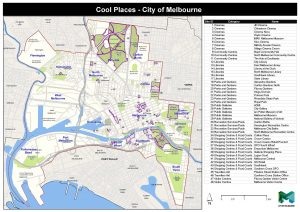Why Climate Change Matters
Climate change has affected the natural environment and humans for centuries. From droughts beginning the decline of the Maya to the Vikings of Greenland being forced out to lowering temperatures, climate change has changed the way humans live. Understanding why it is happening and how we can slow down its effects will pave the way for a cleaner and greener future. The clearest present-day impacts of climate change in Australia and elsewhere are seen in the natural environment and are associated with warming temperatures and increases in the number, duration, and severity of heatwaves. These impacts include changes in the growth and distribution of plants, animals, and insects; negative shifts in the distribution of marine species; and increases in coral bleaching on the Great Barrier Reef and Western Australian reefs. Some of these changes can directly affect human activities; for example, through the effects of changing distributions of fish and other marine organisms on commercial and recreational fisheries, and the impacts of coral bleaching on tourism. With 85 % of all Australians living within 50 km of the shoreline, it is easy to see how devastating climate change can and will be.
Who Climate Change Affects

The population of Melbourne in 2018 was 4.9 million individuals. There are 1.8 million households in Melbourne with that number expected to grow to 2.4 million by 2036. Preparing these homes for the impacts of the future is critical to a resilient city.
![]()
With 31.7% of the public being 24 years of age or younger, it is extremely important to empower and educate this group in order for them to take action and make a difference. The Australian Youth Climate Coalition (AYCC) is the largest youth organized group in Australia trying to solve the climate crisis while educating the future of Melbourne.
Upon increasing temperatures, multiple cities in Victoria will be experiencing weather that is not normal for their ecological areas.
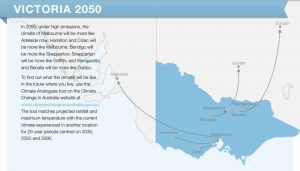
Credit: climatechange.vic.gov.au
These increasing temperatures will ultimately create more arid and unlivable cities.

Credit: climatechange.vic.gov.au
Negative Effects
Heat
Melbourne experiences nine very hot days (where temperatures exceed 35 degrees C or 95 F) on average each year. Climate models suggest this number will increase by up to 26 days on average by 2070. Heatwaves (five or more consecutive days of temperatures exceeding 35 degrees) are also predicted to increase in frequency.
Hundreds of people die each year from conditions exacerbated by extreme heat. The very young, elderly or sick are most vulnerable to extreme heat
Built-up areas experience higher temperatures than surrounding areas due to expanses of exposed concrete, asphalt, and steel which retain heat and release it over longer time periods than vegetation. This can cause average urban daytime air temperatures to be up to 5.6°C higher than the surrounding areas in summer. This means taking health precautions is particularly important during days of extreme heat in the city.
Higher temperatures have been correlated to increased levels of violence and antisocial behavior. Research undertaken for the City of Melbourne in 2012 indicated that the number of assaults in the municipality increased by 6.62 incidents per 100,000 persons for every one-degree temperature increase above 32 degrees.
Very hot days and heatwaves place stress on the provision of essential services such as electricity and many types of infrastructure including roads, train and tram tracks, and overhead power lines. Increased use of air-conditioners pushes up demand for power during heatwaves and can potentially outstrip supply leading to power blackouts. This risk has significant implications during a heatwave, particularly for those managing their heat stress with air-conditioning.
Not only is there a great threat to human health but there is also a risk of economic disaster. It is estimated that during the four-day January 2014 heatwave (14-17 January) businesses across the City of Melbourne experienced a $37 million decline in revenue. This equates to almost $10 million in lost revenue per day. Certain sectors such as retail and food and beverage appear to have been harder hit than others.
Credit: melbourne.vic.gov.au
Drought
Noting that Melbourne is likely to experience much warmer weather in the coming years, it is also very likely that the Melbourne water supply will come across some challenges.
The increasing frequency of drought and reduced rainfall poses challenges to Melbourne’s water supply, as well as the health of parks, trees and green spaces throughout the city.
Between 1998 and 2007 rainfall was 14 percent below average in Victoria. The annual average rainfall is predicted to decrease by 4 percent by 2030 and 11 percent by 2070, with the largest declines occurring in spring.
Fire risk will also become greater as droughts become more severe. The warmer, drier and longer summers expected in Victoria are very likely to increase the frequency and intensity of bush fires – with flow-on effects for air quality.
Credit: melbourne.vic.gov.au
Rising Sea Levels
Climate change is projected to increase average sea-levels along Victoria’s coast by 5 to 15 cm by 2030 and 26 to 59 cm by 2070. These changes will increase the likelihood and severity of floods and other inundation events like storm surges in Melbourne.
While the risks posed by sea-level rise are relatively negligible during the immediate future, they become far more concerning by 2070 with current climate change projections. Higher sea levels in 2070, coupled with more intense storms and increased storm surge heights, will greatly expand the coastal and riverine areas likely to be inundated by storm events. To see areas affected by increasing sea levels, go here.
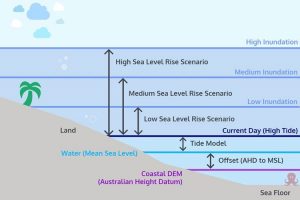
Credit: melbourne.vic.gov.au
What Is Being Done?
Immediate action to combat climate change is going to be crucial in the slowing of extreme temperatures, drought, and rising sea level. Melbourne has a list of initiatives and goals to move in the green direction for both the long and short term.
Urban Forest Strategy
The Urban Forest Strategy is a direct solution for urban heating and the Urban Heat Island Effect. With growing populations, climate change, and urban heating there is increasing pressure on the existing infrastructure and services of the city. Ensuring there is a thriving urban forest is critical to keeping a healthy and livable city.
The strategy aims to:
- adapt our city to climate change
- mitigate the urban heat island effect by bringing our inner-city temperatures down
- create healthier ecosystems
- become a water-sensitive city
- engage and involve the community.
We will achieve this by:
- increasing canopy cover from 22 percent to 40 percent by 2040
- increasing forest diversity with no more than five percent of one tree species, no more than ten percent of one genus and no more than 20 percent of any one family
- improving vegetation health
- improving soil moisture
- improving biodiversity
- informing and consulting with the community.
To help visualize this goal, an interactive map was made showing where individual trees within the city are and even see what the life expectancy and ID of each tree are. You can access this interactive map here.
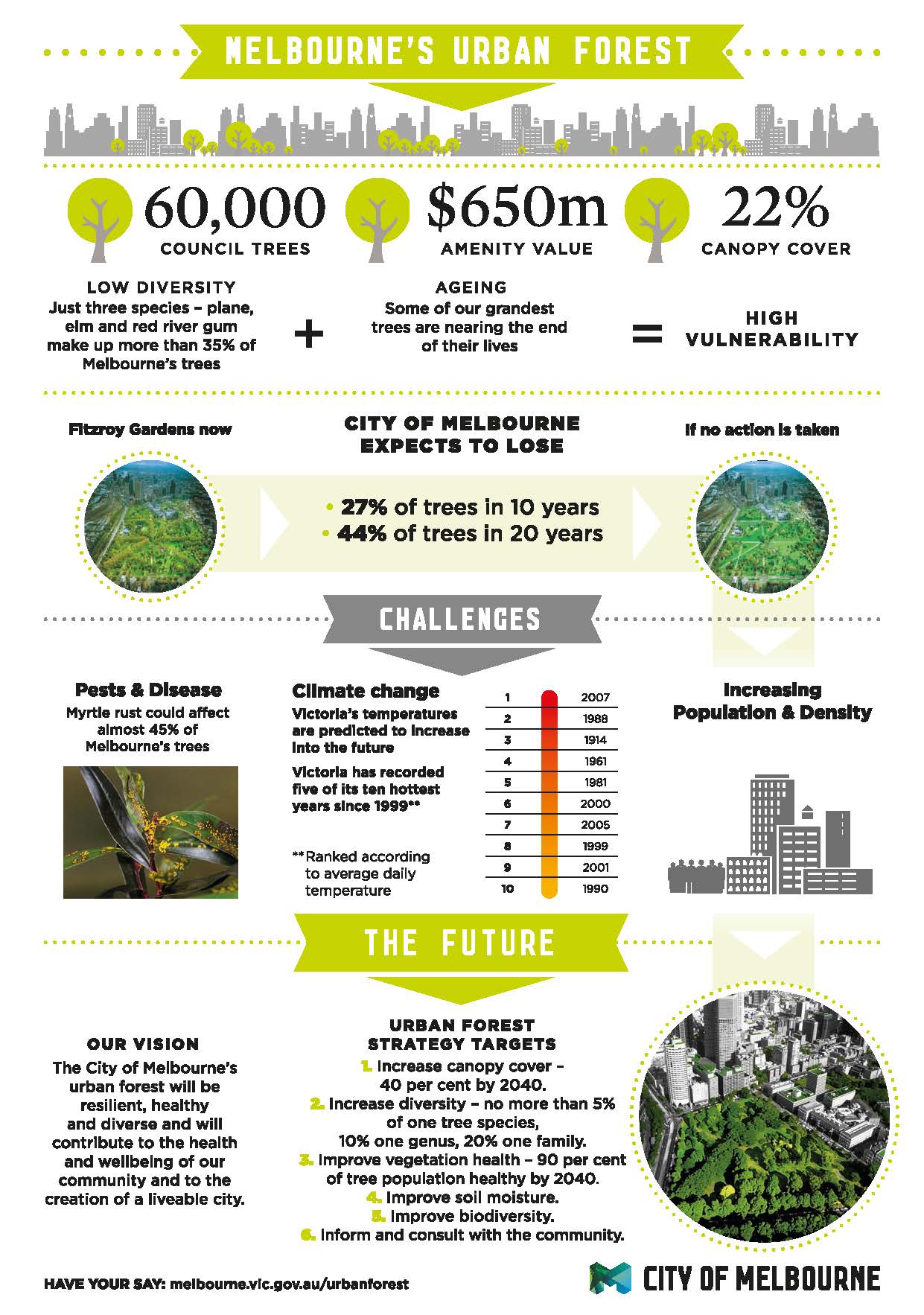
Credit: melbourne.vic.gov.au
Cool Roofs
Cool Roofs are strategies to reduce the heat transferred from roof to building and the surface below in an effort to mitigate the Urban Heat Island Effect. Most of the roofs in the world are dark-colored. This means in full sun, they absorb an extreme amount of heat, reaching up to 100 degrees F warmer than the ambient temperature. Using a cool roof will:
- Reduce energy use: A cool roof transfers less heat to the building below, so the building stays cooler and uses less energy for air conditioning.
- Reduce air pollution and greenhouse gas emissions: By lowering energy use, cool roofs decrease the production of associated air pollution and greenhouse gas emissions.
- Improve human health and comfort: Cool roofs can reduce air temperatures inside buildings with and without air conditioning, helping to prevent heat-related illnesses and deaths.
Utilizing cool roofs is an effective way to combat urban heating. Minimizing the urban heat island effect will make Melbourne a more resilient city.
Credit: certainteed.com, melbourne.vic.gov.au
Adaptation Strategy
In 2009, Australia released The Climate Change Adaptation Strategy which outlined a list of desired goals and outcomes for the coming years as well as methods for achieving these goals. Within this document, there were research and assessments of climate change risks for 2010, 2030, and 2070. The most recent version can be viewed here.
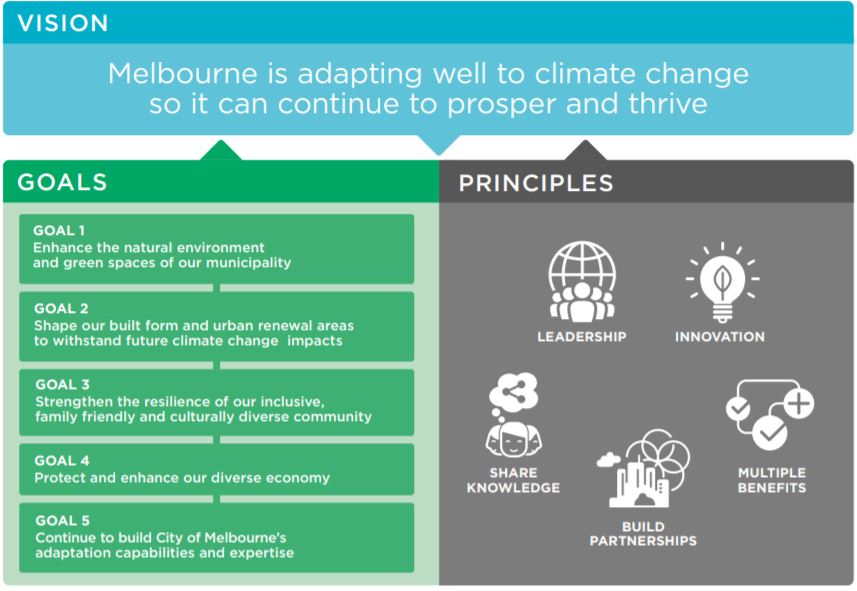
Sources
https://www.melbourne.vic.gov.au/about-council/vision-goals/eco-city/Pages/adapting-to-climate-change.aspx
https://www.environment.gov.au/climate-change/climate-science-data/climate-science/impacts
https://www.climatechange.vic.gov.au/__data/assets/pdf_file/0018/60750/Statewide-Victoria.pdf
https://www.science.org.au/learning/general-audience/science-climate-change/7-what-are-impacts-of-climate-change
https://theconversation.com/rapid-growth-is-widening-melbournes-social-and-economic-divide-117244
https://www.environment.gov.au/system/files/resources/fa553e97-2ead-47bb-ac80-c12adffea944/files/cc-risks-full-report.pdf
https://www.melbourne.vic.gov.au/sitecollectiondocuments/climate-change-adaptation-strategy-refresh-2017.pdf
https://www.certainteed.com/residential-roofing-commercial-roofing/what-cool-roof-0/
https://ozcoasts.org.au/maps-data/
http://www.coastalrisk.com.au
